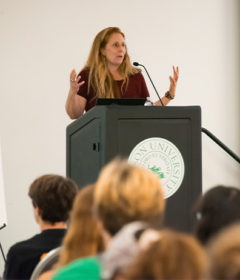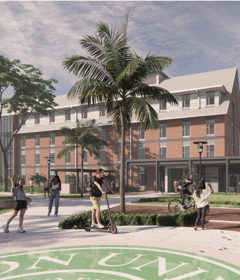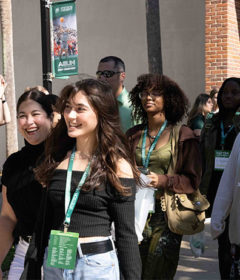Sarah Caudill ’06: ‘When Neutron Stars Collide’
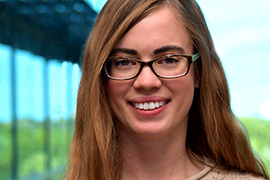
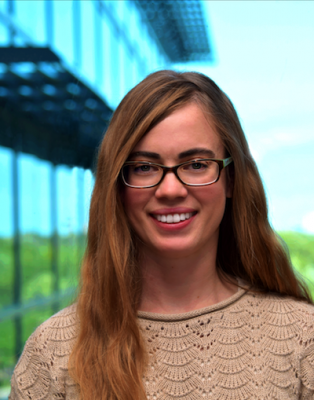
Sarah Caudill didn’t plan to major in physics at Stetson University, but her career trajectory changed when one of her professors loaned her a book, “Black Holes & Time Warps: Einstein’s Outrageous Legacy.”
Caudill ’06 devoured the book, recalled Kevin Riggs, Ph.D., Stetson professor and chair of Physics. And it set her on a course to intern at Caltech and meet the book’s author, physicist Kip Thorne.
Thorne was awarded the 2017 Nobel Prize in Physics last fall, along with two other physicists, for detecting gravitational waves — “ripples” in the fabric of space-time that occur when massive objects like black holes collide.
The team’s LIGO (Laser Interferometer Gravitational-wave Observatory) recorded the first direct detection of gravitational waves in 2015, 100 years after Albert Einstein predicted their existence.
Caudill, Ph.D., has worked with this research team since her days at Stetson, continuing as a doctoral student at Louisiana State University, a postdoctoral researcher at the University of Wisconsin-Milwaukee, and now as a gravitational-wave scientist for the Dutch National Institute for Subatomic Physics in Amsterdam.
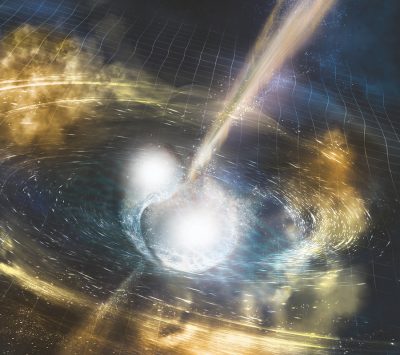
She will return to campus to give the keynote address at the Stetson Showcase banquet on April 17 and a public talk on April 16 about the team’s latest discovery. On Aug. 17, 2017, the team detected a gravitational wave signal from two neutron stars that collided nearly 130 million years ago. The collision produced a light show captured by astronomers, marking the first time such a cosmic event was viewed in both gravitational waves and light waves.
“Because we detected those gravitational waves, we were able to tell astronomers to turn their telescopes and look and see the fireworks,” Caudill said from Amsterdam via Skype. “And so astronomers detected all sorts of light coming from this collision and I’m going to talk about all of the science that we’re able to do because of detecting the gravitational waves, plus the light, and how this information gets combined to do fundamental physics.
“I also want to tell the detection story and how lucky we were to find the signal,” she said. “It’s going to be a story of how we almost missed seeing the signal right away and almost missed out on recording new physics in real time.”
‘Work Ethic and Talent’
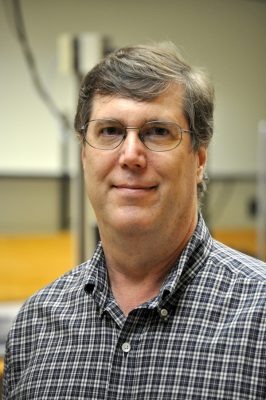
Caudill, a Volusia County native, enrolled at Stetson as a chemistry major after graduating from New Smyrna Beach High School, and planned to become a medical examiner. In her first year at Stetson, she made an impression on Tandy Grubbs, Ph.D., professor and chair of the Department of Chemistry and Biochemistry, and he asked her to work in his lab that summer.
“He actually recruited her to do a summer internship in his lab, which fortunately had to do with measuring properties of photo-cured plastics, or polymers, using Michelson interferometers — believe it or not — laser interferometry,” Professor Riggs said. “That’s how she got her first experience in actually doing interferometry.”
Chemistry majors are required to take an introductory course in physics, which Caudill took her sophomore year, and “fell in love with physics, much to Tandy Grubbs’ consternation,” joked Riggs.
As her interest in physics grew, Riggs lent her Thorne’s 1994 book on black holes and time warps. She pored over it and applied to Caltech for a summer internship.
“I think it’s a combination of having a strong interest in modern physics and having that summer internship experience with Tandy Grubbs in the interferometry lab that got her to Caltech,” Riggs explained. “And that was where everything fell together.”
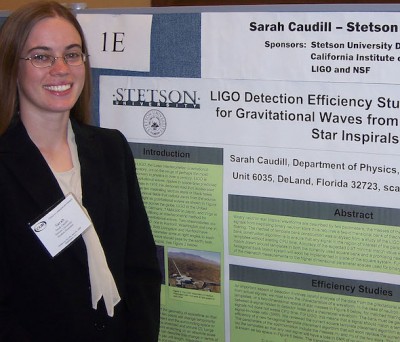
While interning at Caltech in 2005, she asked Thorne to sign the borrowed copy of the book for Riggs.
“I really cherish the inscription,” Riggs said. “It says: ‘To Kevin Riggs, with best wishes and appreciation for your teaching students like Sarah, Kip Thorne.’ It’s the most cherished book in my book collection.”
The internship put Caudill on the research team in the years leading up to its direct detection of gravitational waves — the “Discovery of the Century” — in 2015. But her success stems from far more than being in the right place at the right time, said Riggs, who mentored Caudill on her senior research project involving LIGO.
“She also has the most wonderful combination of work ethic and talent that I’ve ever seen in my 30 years of teaching,” he added.
‘So Much to Do and Learn’
After graduating from Stetson with a degree in physics, Caudill earned a Ph.D. in physics from Louisiana State University. She worked under the direction of Gabriela González, Ph.D., a professor of physics and astronomy who served as the official spokesperson for the LIGO collaboration.
LIGO is operated jointly by Caltech and MIT, and funded by the National Science Foundation. The team built two detectors, one in Hanford, Washington, and the other in Livingston, Louisiana, and began their search in 2002. Later, the detectors were redesigned and upgraded in 2014, providing the increased sensitivity needed for their historic discovery the following year.
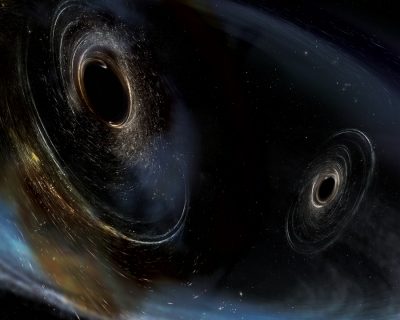
LIGO/Caltech/MIT/Sonoma State (Aurore Simonnet)
Each observatory has two-and-a-half-mile-long arms that contain a LIGO interferometer. This splits a single beam of laser light into two beams and send these beams traveling back and forth down the arms between mirrors at the ends.
According to Einstein’s Theory of General Relativity, when massive objects like black holes collide, a portion of their combined mass is converted to energy. This energy is emitted as gravitational waves, causing a distortion in space-time, like ripples in a pond when a rock is thrown in.
These gravitational waves reached Earth 1.3 billion years later, and were detected by LIGO in 2015 when the distance between the mirrors changed by an infinitesimal amount — smaller than one-ten-thousandth the diameter of a proton. (Protons are particles found in the nucleus of atoms.)
Speaking recently from Amsterdam, the 34-year-old Caudill possessed an exceptional ability to talk about physics and Einstein’s theories in a way that the rest of us can follow – at least a little bit. This observation made her laugh.
“I was actually talking to my husband about that the other day,” she said, “because I was having to review some GR theory for a course I’m going to teach and I was like, this is hard stuff, and he said, you’re one of – I don’t know – not that many people on Earth who can understand this, and I said, wow, yeah, I guess you’re right.
“Every day, I feel like there’s still so much to do and learn. It’s like Einstein said, ‘The more I learn, the more I realize how much I don’t know.’”
‘The Next Science Run’
Caudill started work last August at the Dutch National Institute for Subatomic Physics, called Nikhef, in Amsterdam. There, she has joined the Europe-based Virgo team with a detector near Pisa, Italy, and “listens” for signals deep in the data that could reveal gravitational waves from a cosmic event. These signals actually have been modeled into audible signals, like “chirps.”
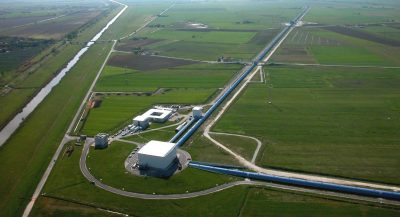
Her first month on the job turned out to be “a busy month,” she said. The team recorded its first triply detected signal, in which the two LIGO detectors in the United States and Virgo in Italy detected a binary black hole system. And the detectors also picked up the “spectacular collision of two neutron stars.”
That will be the subject of Caudill’s public talk at Stetson on April 16 at 7:30 p.m. in the Rinker Auditorium of the Lynn Business Center: “When Neutron Stars Collide: Cosmic Messages from GW170817.”
The Dutch institute hired Caudill for a tenure-track position and will evaluate her after six years. If the institute likes her work, she will stay on permanently, and she and her husband Josh Montminy will “integrate into Dutch society,” she said.
“I like the country,” she said. “I think a lot of the ideas they have here are really cool. They’ve got a good program for women, as well, in the workplace. There are pretty good opportunities for maternity leave and holiday and things like that, so it seemed like a good position for me.
“The other thing that’s really good about it is that it’s mostly researched-based and in the U.S. it’s difficult to find a research-based position that’s not also a very heavy teaching load. … Here, I get to spend a lot of time doing gravitational wave research, so that’s very exciting and that sort of position would be hard to find in the U.S.”
Currently, the LIGO and Virgo detectors are off-line as they are upgraded to again increase their sensitivity. That may open new windows to more discoveries, including an ongoing question for Caudill and the team.
“The deeper science that the group is doing is just testing general relativity and trying to see if the signals we’re seeing are 100 percent consistent with general relativity, as Einstein told us 100 years ago or are there little changes in the signal that might hint that the theory of general relativity is not 100 percent correct. But so far everything has been found consistent with the theory that Einstein formulated 100 years ago,” she explained.
“In particular, we’re looking for really loud signals, which are actually expected with the increased sensitivity in the next science run, so when it comes back online in fall we might actually see a signal that will really be loud enough that we can see these little changes in the signal that might indicate there’s something new, new physics, new ideas about gravity in there. So, that’s what we’re hoping for.”
-Cory Lancaster

